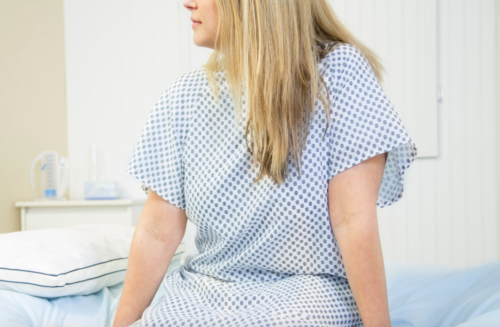Tuesday at Mass General hospital in Boston was supposed to be a long day, but an easy one. All I had to do was have pictures taken of how things looked inside my skull and neck with a CT scan and an MRI, nothing I hadn’t done at least several times before. In fact, the night before when I struggled to get a good night’s sleep I thought, “It’s Ok, I can nap inside the machines.”
Instead, I ended up half-naked on my hands and knees in the streets of Boston, violently throwing up every last grain of my steel-cut oats breakfast while my body blocked the entrance to the hospital parking garage. How did I get there?
That day, Dr. Liebsch, our radiation specialist at Mass General, wanted the most detailed images possible of my head and neck in order to create a radiation plan for me. Proton-Beam radiation is a powerful and effective means of zapping a tumor without damaging surrounding tissue. To get an accurate photo-map of where the tumor is and where the healthy tissue lives, they needed to inject color contrast into my spinal fluid and let it move to the top of my neck before sending me into the CT scan and MRI machines. Dr Liebsch explained that I would need to lie on a table tilted slightly toward my head and that I might experience a headache for up to three days afterwards.
Dr. Liebsch has silver hair but looks younger than his 60 some years. He is not very tall and has a soft, round face. He explains complex issues in a thick German accent with a voice just above a whisper as he calmly waves away concerns with long fingers and manicured nails. But looks are deceptive; Dr. Liebsch is tough, strict, and fiercely dedicated to getting the details right. He once took 45 minutes to explain how he wanted my short medical history organized on paper. Another day, he spent 2 hours crafting a fiberglass mask of my face and neck to hold my head in exactly the same position every time I had images taken or received radiation. We liked his fastidiousness; it was a good quality trait in someone who is in charge of radiating your skull.
On Tuesday, we arrived in time for me to change into a hospital gown and go straight to the room where they were going to inject the contrast fluid. Maybe it was Dr. Liebsch’s accent, but in all of his instructions, I missed the part about the new guy (a resident doctor) doing the spinal tap on me. I also missed the part about how they needed to strap my ankles into leather buckles so I wouldn’t slip off the table when they turned me upside down to let the contrast do its magic. The “magic” gave me a raging headache, made worse because I was lying on my stomach and had to really concentrate to breathe fully. Finally they straightened me out, rolled me onto a stretcher, and pushed me into an elevator and down several hallways to another room where I promptly threw up several times from the headache pain. Throwing up is never fun, but throwing up with a recent neck fusion is a whole new kind of painful. This was no one’s fault; I was having a rare, unexpected, bad reaction to the contrast that was not dangerous, just annoying.
“You ok?” Dr. Liebsch asked.
I gave the thumbs up.
“Good,” he said, “Now you must lie on the floor and roll around to mix the contrast up.” I waited to see if he was joking and he only gave me his hand to help me off the table. I handed the nurse my motion sickness bag and slowly lay down on the tile floor. Then I rolled back and forth with all the grace of someone in a neck brace who has just thrown up several times and now discovers that she is on fire. When they said I could stop, I crawled back onto the table and lay flat on my back. Then they pressed the fiberglass mask tightly over my face and neck before sliding me into the machine. Somehow, I did not throw up.
When the scan was over, I met Kurt in the waiting room where he pointed out that my hospital gown only had one working tie at the neck and the rest was wide open to the world. Meanwhile, the fire alarm was going off in the building, but no one seemed to pay any attention. We left anyway as we had some time to kill before the next series of pictures. Outside, the fresh air felt cool on my face and I instantly felt better. Until suddenly, I didn’t. The next thing Kurt and I knew, I was buckled over in my useless gown, throwing up knives, or so it felt. There wasn’t anything wrong, it was just a bad reaction, but the freshness of my scars from the surgery and the immovability of my neck from the fusion made everything hurt more. I kept thinking, this is as tough as labor. Then the puke started coming out my nose and I couldn’t breathe. No, I thought, this is way worse than labor. It helped to cry. Kurt rubbed my back and tried to steer traffic around us while I puked and cried, puked and cried.
It got better after that. A nurse grabbed a wheelchair and put me in it and wheeled me back to Dr. Liebsch’s office. He immediately gave me an IV with an anti-nausea medication and had me lie down to make the headache stop. He was determined to complete the series of pictures and somehow he knew I could do it. But the MRI machine we were scheduled to use was off-site, so he whisked me into a cab, rolled down the window, and I stuck my head out like a dog as we zoomed along the Charles river and I tried to relax and watch the sailboats and rowing hulls, runners, and trees.
I threw up again into a biohazard bin when we arrived, but somehow felt good enough after that to let them strap that mask back over my nose and mouth and slide me into the MRI machine, this time for 45 minutes. Before going in, the tech handed me a button to push in case of an emergency. But my doctor who was focused on getting all of the images we both knew we needed said to me, “But don’t push it.”
Inside the MRI machine, I watched movies in my head, memories of family vacations on a northern lake or a Mexican beach and when those ran out, I went through a slide show of every relative and friend, pausing on each one’s smile for a three seconds. It worked to distract me from the deafening digital knocking and bell sounds that the machine makes; it also took my mind off the urge to use the button that I was not supposed to use. I knew that if I panicked and pushed it, we would need to start over. However bad I felt now I knew I would feel worse doing this again for another 45 minutes.
Finally, it was all over. We made it back to our hotel without another incident. When I walked into the lobby, an older African American bell hop gave me a big smile. I was still in my ridiculous hospital gown and wearing my neck brace so I wasn’t really in the mood to be seen, but he seemed genuinely happy to see me.
“My name is Thomas. In Jamaica, where I come from, we like to make people happy. May I sing you a song?”
“Sure,” I said.
And right there, in the old Holiday Inn lobby, Thomas started singing to me.
“Rise up this mornin’
Smiled with the risin’ sun,
Three little birds
Pitched by my doorstep,
“Singin’ sweet songs
Of melodies pure and true
Saying’, (this is my message to you),
Singing’ don’t worry ’bout a thing
‘Cause every little thing gonna be alright”
Then we all sang together,
“’Cause every little thing gonna be alright”
I smiled for the first time that afternoon because I believed it. Thomas noticed the smile.
“See, I make you happy!” he laughed.
“Thank you,” I said. And I meant it.
*****
Afterword:
We flew back to Colorado the next day and made it all the way home before the headache slammed me again and I was back in bed and hugging the toilet for the next three days, until the contrast dye was completely out of my system. It was a freak reaction that is over now and I feel weak but getting stronger. What amazes me is how I had a reprieve during the flight; what a gift. It could have been much worse.

